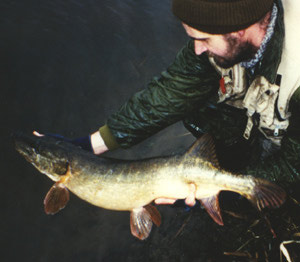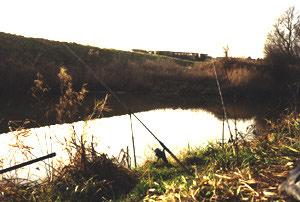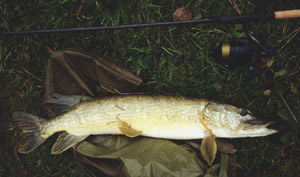 Over
the years I have refined my small drain fishing techniques on the mighty River
Crossens (made as legendary as himself by Gord Burton), and the other small and
shallow drains and canals around Southport. These drains, if truth be told, are
pretty poor pike waters by national standards, even when compared to similar waters
in other parts of the country. Where you might expect a few doubles each day on
certain of the eastern drain systems, you will be looking at a few doubles a season
in the northwest. While fen drains produce pike to thirty pounds now and again,
a twenty from the Southport 'fens' is a rare sight indeed. Despite this gloomy
picture, what I have learned on my local drains has helped me out elsewhere on
shallow and narrow waterways.
Over
the years I have refined my small drain fishing techniques on the mighty River
Crossens (made as legendary as himself by Gord Burton), and the other small and
shallow drains and canals around Southport. These drains, if truth be told, are
pretty poor pike waters by national standards, even when compared to similar waters
in other parts of the country. Where you might expect a few doubles each day on
certain of the eastern drain systems, you will be looking at a few doubles a season
in the northwest. While fen drains produce pike to thirty pounds now and again,
a twenty from the Southport 'fens' is a rare sight indeed. Despite this gloomy
picture, what I have learned on my local drains has helped me out elsewhere on
shallow and narrow waterways.
The
most important lesson I have learned is the importance of being quiet and keeping
a low profile. Most of the sections of drain that I fish have banks a good three
feet or more above the water at summer level, and in winter, when the drains are
pumped to drain the surrounding fields, you are even higher above the water's
surface. In most places the depth is less than five feet in the summer, and in
winter it is possible to be fishing in eighteen inches or so in places. Given
the closeness of far bank, the need for a stealthy approach should be obvious.
If
intending to fish a swim that involves a walk of any length, I always try and
keep as far away from the water's edge as possible and to make my footsteps as
light as I can, especially when I get within fifty yards or so of the spot. Because
I am convinced that the fish on these drains move about quite a bit, I don't want
to unduly spook any fish that are between the access point and my selected swim.
I certainly don't want to send them off in the other direction, or move them beyond
my swim. Why do the best match weights usually come from the end pegs? That's
right, they are the ones that nobody has walked past, the ones that have been
least disturbed!
Standing
up on a high bank, one with no cover whatsoever behind you, is a real no-no. Even
to a pike in muddy water you will be silhouetted against the sky. So, if fishing
in company try to avoid the temptation to impersonate a small flock of penguins
standing guard over one of the rods!
Once
at my fishing position I set my gear down well away from the water and try to
avoid even sitting on a chair. Sitting on the ground, protected from cold and
damp by a camping mat and a folding back rest, rather than a low chair, presents
a lower profile. Umbrellas, when needed, are kept as low as possible too. If I
can do without the brolly and chair I will, not least because they are extra weight
to carry.
The rods are set
up away from the water's edge and when baited and ready I creep towards the drain.
Not usually on all fours, I admit (although it has been known), but crouching
low and walking as slowly and quietly as I can. The rod rests are carried along
with the rod in order to minimise the number of times I have to approach the water's
edge. If I can, I will swing the baits out under arm, again to avoid unnecessary
movement above the skyline. If I want to fish a bait or two well up or down the
drain from my base camp, I walk along the bank, away from the edge to the spot
I want to fish the rig, and swing it into place. Often I will cast out from a
kneeling position, particularly if dropping a bait under the near bank. Then I
walk quietly back to the rod rests and set the rod up. In order to keep disturbance
to a minimum I rarely position a bait directly opposite to where I
am sitting. This way I reduce the chances of alarming fish by my movements when
I get up to move a bait or attend to a rod for any other reason.
 The
approach that I have developed on the drains is not based on the leap-frogging
tactic that is usually recommended when drain fishing is discussed, but on a semi-static
mode of operation. In the early days I tried leap-frogging, and while it worked
well on the local canal, it never did me any good on the drains. I am convinced
that this is because the canal pike are more evenly spread out than the drain
fish just a few miles away. If you have a lot of pike spread along a drain or
canal, none of them moving far from their holding spots, then by covering a lot
of water leapfrogging rods, you will regularly be putting a bait in front of different
fish. On the other hand, if you have fewer, but more mobile fish, it is better
to wait for them to come to you. I always think that moving a bait under these
circumstances is just as likely to move it away from a pike as it is towards one.
The
approach that I have developed on the drains is not based on the leap-frogging
tactic that is usually recommended when drain fishing is discussed, but on a semi-static
mode of operation. In the early days I tried leap-frogging, and while it worked
well on the local canal, it never did me any good on the drains. I am convinced
that this is because the canal pike are more evenly spread out than the drain
fish just a few miles away. If you have a lot of pike spread along a drain or
canal, none of them moving far from their holding spots, then by covering a lot
of water leapfrogging rods, you will regularly be putting a bait in front of different
fish. On the other hand, if you have fewer, but more mobile fish, it is better
to wait for them to come to you. I always think that moving a bait under these
circumstances is just as likely to move it away from a pike as it is towards one.
By
using floats on my rigs most of the time, I have had my belief reinforced that
the pike on my drains are nomadic. Rarely do they pick up baits and stick around,
more often than not they set off up or down the drain and don't turn back. The
canal fish mostly take a bait without the float moving more than a few feet. The
nomadic nature of these drain pike is also pointed out by repeat captures just
days apart, when fish have moved a few hundred yards, or sometimes more. I like
to think that the way runs will come from one swim throughout the day is indicative
of mobile pike passing through, whereas static fish in a 'hotspot' are more likely
to feed in short bursts at specific hours. I could be wrong in this assumption
but my limited experience of true hotspots indicates this behaviour.
While
I don't like to move swims too often, I will reposition baits during a session.
Moving baits around a swim is always a good idea, especially when alternative
presentations are being used. Both near and far bank options are always covered
and the centre of the drain is not neglected either. Far too often I see anglers
concentrating all their attention on the far bank. Perhaps this is wise if you
are blundering about on the bank all day, casting shadows on the water and creating
other pointless disturbances. By being stealthy near bank, baits will get taken
regularly. The pike don't know which the far bank is, both banks are the same
to the fish!
Lures and wobbled
baits don't play much part in this style of drain fishing as they involve more
movement on the angler's part and are best carried out from a standing position.
However, I will occasionally give one of these methods a go, fishing between my
static rods. Often I will have a few chucks as soon as the baits are out, and
sometimes pick up a pike straight away. Alternatively I will thrash the area immediately
before vacating it, just in case something has moved in and can be provoked to
take a moving bait. Then again, when I am spending all day in one spot, the mobile
baits will be used intermittently throughout the day when things are quiet. Admittedly
this can be done as much to relieve the boredom as it can to catch try and catch
something, but now and again it does just that.
Although
I am frequently content to spend a whole winter's day in one spot, there are times
when I get the urge to move. So, rather than leapfrog (which I feel involves too
much moving around on the bank and creates too much disturbance) I will up sticks
completely and transfer my entire camp to another spot. If this is just a couple
of swims away, and sometimes that has been far enough to turn a blank into a red
letter day, I might do it in two trips. Rods first then the rest of the gear.
If the distance is greater then I will pack everything away, bar the baited rods,
and move it all in one go.
 It
is always worth a bit of pre-planning when setting out to fish like this on the
drains. Try and fish the farthest swim you fancy first in the day, then move back
towards the access point as the day progresses. Moving away from the access as
the day goes on is not very tiring, but the long walk back in the evening can
be a killer. Do the hard bit first, then when you come to pack up, the car will
be just a shortish walk away. Make life easy for yourself! If possible I prefer
to make the initial trek downstream, although this is not always a practical plan
to put into action given the location of good stretches in relation to access
points. The reasoning behind this is that every time you move up-stream, pike
that might have been following scent trails off your baits will pick them up again
when they are recast in your new swim. If a fish has just entered your original
spot and you then move off downstream, it is not going to find a new scent to
follow. I admit that this is a bit of a tenuous concept. However, it is worthy
of some consideration, as I am convinced that pike on small drains do home in
on the smell of deadbaits, and any additives that you might be using with them.
It
is always worth a bit of pre-planning when setting out to fish like this on the
drains. Try and fish the farthest swim you fancy first in the day, then move back
towards the access point as the day progresses. Moving away from the access as
the day goes on is not very tiring, but the long walk back in the evening can
be a killer. Do the hard bit first, then when you come to pack up, the car will
be just a shortish walk away. Make life easy for yourself! If possible I prefer
to make the initial trek downstream, although this is not always a practical plan
to put into action given the location of good stretches in relation to access
points. The reasoning behind this is that every time you move up-stream, pike
that might have been following scent trails off your baits will pick them up again
when they are recast in your new swim. If a fish has just entered your original
spot and you then move off downstream, it is not going to find a new scent to
follow. I admit that this is a bit of a tenuous concept. However, it is worthy
of some consideration, as I am convinced that pike on small drains do home in
on the smell of deadbaits, and any additives that you might be using with them.
Small,
shallow drains are not always brilliant pike waters, but they are nonetheless
interesting fisheries which can teach you a lot. With a bit of careful thought,
and an equally careful approach, they can also give you better results than you
might have previously anticipated.
(This
article first appeared in Pike and Predators)

